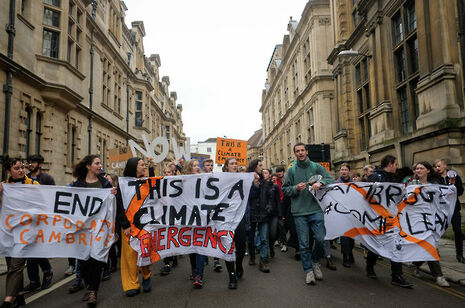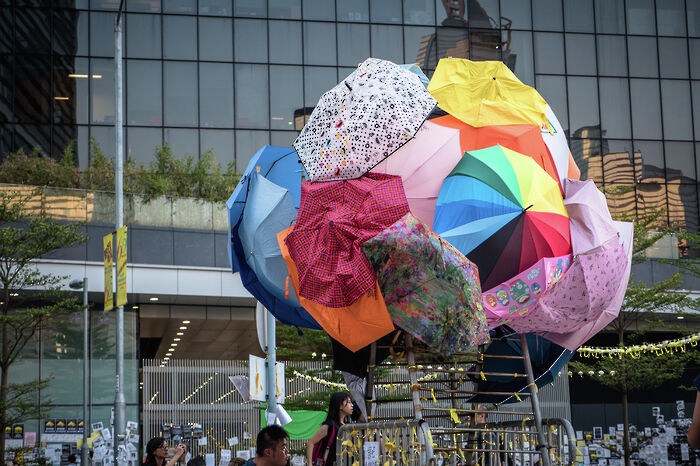The art of protesting
Can parodies and posters have a serious impact? Emily Blatchford discusses the ways in which artistic creativity can give power to the voices of protesters

Whether you take a look at the 2018 Women’s March or the March for Our Lives, the forthright marchers allow their voices to be heard. This is not just through chants and shouts but through an evolving art form – the protest sign.
On the 20th of January, a year after Trump was elected, the 2018 Women’s March took place across America and around the world. On the 24th of March, around 800,000 people marched on Washington DC protesting gun violence in the United States and demanding reasonable gun control legislation. Since its eruption in 2013, the Black Lives Matter campaign has continued poignantly across both continents. There has been Cambridge’s own Zero Carbon society stunts, demonstrations against the vote of Brexit, protests endorsing animal rights across the world. Undoubtedly, protests are a dominant feature of the current political landscape, from Hong Kong’s ‘Umbrella Revolution’ to the current anti-rape protests in southern India, and even Cambridge during the recent strikes.
Each of these posters is a unique voice and stands for a unique perspective on what it means to fight for rights
The protesters who get behind these critical causes are from all walks of life, backgrounds and experiences. They amplify both their collective and individual voices with beautiful, vibrant and colourful signs. These are sarcastic and witty, cynical even, poking fun at internet memes, and toying with popular culture references. From “My arms are getting tired from hold’n this sign since 1960s” to “Without Hermione Harry would have died in book 1 #girlpower” (seen at the 2018 Women’s March), such signs often pack an emotional punch, reclaiming symbols and slogans, and transforming them to speak their own views. There are puns and word-play such as “Ovary-acting? Nope” and “Super callous fragile racist sexist not my potus”; references to popular media (“This episode of Black Mirror is terrible”); and bold drawings and caricatures of the President and other leading figures.
Most of these signs are funny, even cute – especially when attached to adorable young child or puppy. Some critics have even gone so far as to call them flippant. Certainly they are impressed with their own cleverness and marvel at their cheek. They are the perfect new addition to that aesthetically pleasing Instagram post. But are they making light of serious topics? Can the deaths of 17 people at a Florida High School on February 14th be protested with a parody of Mean Girls’ Regina George – “Stop trying to make guns happen”?
It seems that the art of resistance is more strikingly individual than ever before
I think they can. If you take the flippancy for catchiness, it allows ideas and arguments to hit home in new ways. If you look at the popular culture references and parodies of memes as complex irony, it shows a fascinatingly poignant self-awareness – an art form which reflects the world it was developed in. If you take the use of social media less cynically, the influence of Instagram allows these works to have a second life and continue to have an impact. Moreover, the humour and the sassy punchlines gives a confident voice to people who often feel as if they aren’t given one, each with just enough recognition of the seriousness of the struggle. Sincerity and humour seemed to work together not against one another.
Yet this flippancy is not the only way. Looking at the Black Lives Matter movement in particular, these signs often pack an emotionally powerful punch, for example: ‘They tried to bury us. They didn’t know we were seeds’. Crucially however these protest signs, from whatever protest, all express personalities and individuality within a shared goal. They are unique. Each sign has its own originality. They are a handmade art, reflecting their maker, the person proudly holding it, their background and their beliefs. It is an incredibly personal political statement. Therefore, it is no surprise that the official Women’s March signs undersold. People want to navigate their own thoughts and march for their own reasons, without, it seems, privileging one voice above the other.
Are protests no longer about who shouts loudest? Are they instead about a sea of equally brilliant protest signs with equally valid voices? Perhaps this is going too far. But each of these posters is a unique voice and stands for a unique perspective on what it means to fight for rights, to be be a woman, or to be faced with gun violence. It seems that the art of resistance is more strikingly individual than ever before. People are getting creative about what activism and protest could or should look like.
 Features / 3am in Cambridge25 June 2025
Features / 3am in Cambridge25 June 2025 Comment / Why shouldn’t we share our libraries with A-level students?25 June 2025
Comment / Why shouldn’t we share our libraries with A-level students?25 June 2025 News / Revealed: Emmanuel relies most on postgrad supervisors28 June 2025
News / Revealed: Emmanuel relies most on postgrad supervisors28 June 2025 News / Gardies faces dissolution27 June 2025
News / Gardies faces dissolution27 June 2025 Sport / Sport, spectacle, and sanctioned collisions: May Bumps 202525 June 2025
Sport / Sport, spectacle, and sanctioned collisions: May Bumps 202525 June 2025






